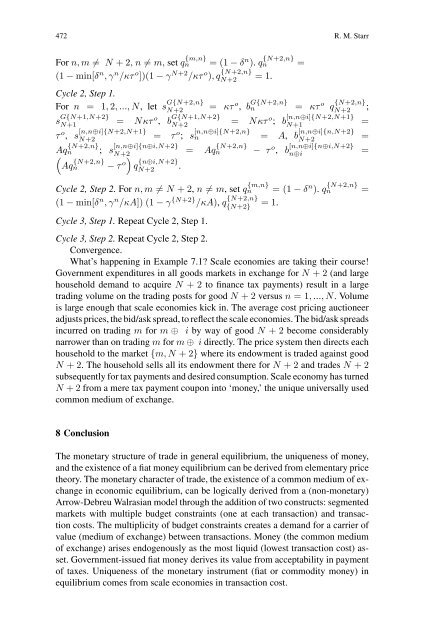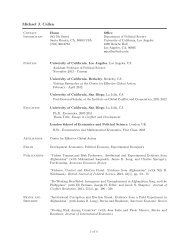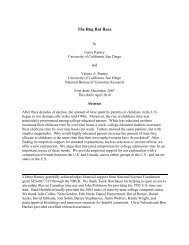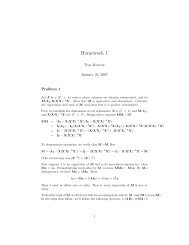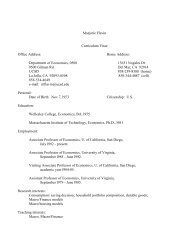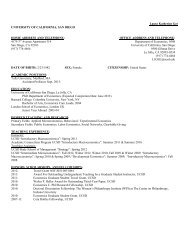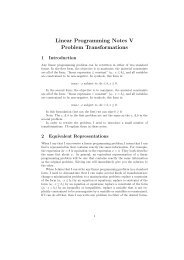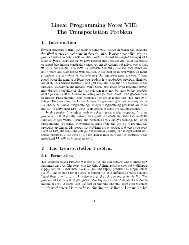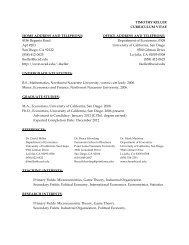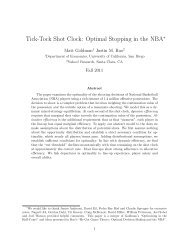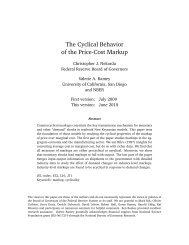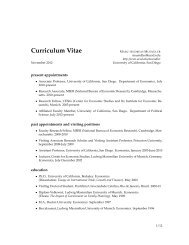Endogenous derivation of 'money' - UC San Diego Department of ...
Endogenous derivation of 'money' - UC San Diego Department of ...
Endogenous derivation of 'money' - UC San Diego Department of ...
Create successful ePaper yourself
Turn your PDF publications into a flip-book with our unique Google optimized e-Paper software.
472 R. M. Starr<br />
For n, m = N +2,n= m, set q {m,n}<br />
n<br />
=(1− δ n ). q {N+2,n}<br />
n<br />
(1 − min[δ n ,γ n /κτ o ])(1 − γ N+2 /κτ o ),q {N+2,n}<br />
N+2<br />
=1.<br />
Cycle 2, Step 1.<br />
For n = 1, 2, ..., N, let s G{N+2,n}<br />
N+2 = κτ o , b G{N+2,n}<br />
n = κτ o q {N+2,n}<br />
N+2 ;<br />
s G{N+1,N+2}<br />
N+1 = Nκτo , b G{N+1,N+2}<br />
N+2 = Nκτo ; b [n,n⊕i]{N+2,N+1}<br />
N+1<br />
=<br />
τ o , s [n,n⊕i]{N+2,N+1}<br />
N+2 = τ o ; s [n,n⊕i]{N+2,n}<br />
n = A, b [n,n⊕i]{n,N+2}<br />
N+2 =<br />
Aq {N+2,n}<br />
n ; s [n,n⊕i]{n⊕i,N+2}<br />
N+2 = Aq {N+2,n}<br />
n − τ o , b [n,n⊕i]{n⊕i,N+2}<br />
<br />
Aq<br />
n⊕i<br />
=<br />
{N+2,n}<br />
n − τ o<br />
<br />
q {n⊕i,N+2}<br />
N+2 .<br />
Cycle 2, Step 2. For n, m = N +2, n = m, set q {m,n}<br />
n<br />
(1 − min[δn ,γn /κA]) (1 − γ {N+2} /κA), q {N+2,n}<br />
{N+2}<br />
Cycle 3, Step 1. Repeat Cycle 2, Step 1.<br />
=1.<br />
=<br />
=(1− δ n ). q {N+2,n}<br />
n<br />
Cycle 3, Step 2. Repeat Cycle 2, Step 2.<br />
Convergence.<br />
What’s happening in Example 7.1? Scale economies are taking their course!<br />
Government expenditures in all goods markets in exchange for N +2(and large<br />
household demand to acquire N +2to finance tax payments) result in a large<br />
trading volume on the trading posts for good N +2versus n =1, ..., N. Volume<br />
is large enough that scale economies kick in. The average cost pricing auctioneer<br />
adjusts prices, the bid/ask spread, to reflect the scale economies. The bid/ask spreads<br />
incurred on trading m for m ⊕ i by way <strong>of</strong> good N +2become considerably<br />
narrower than on trading m for m ⊕ i directly. The price system then directs each<br />
household to the market {m, N +2} where its endowment is traded against good<br />
N +2. The household sells all its endowment there for N +2and trades N +2<br />
subsequently for tax payments and desired consumption. Scale economy has turned<br />
N +2from a mere tax payment coupon into ‘money,’ the unique universally used<br />
common medium <strong>of</strong> exchange.<br />
8 Conclusion<br />
The monetary structure <strong>of</strong> trade in general equilibrium, the uniqueness <strong>of</strong> money,<br />
and the existence <strong>of</strong> a fiat money equilibrium can be derived from elementary price<br />
theory. The monetary character <strong>of</strong> trade, the existence <strong>of</strong> a common medium <strong>of</strong> exchange<br />
in economic equilibrium, can be logically derived from a (non-monetary)<br />
Arrow-Debreu Walrasian model through the addition <strong>of</strong> two constructs: segmented<br />
markets with multiple budget constraints (one at each transaction) and transaction<br />
costs. The multiplicity <strong>of</strong> budget constraints creates a demand for a carrier <strong>of</strong><br />
value (medium <strong>of</strong> exchange) between transactions. Money (the common medium<br />
<strong>of</strong> exchange) arises endogenously as the most liquid (lowest transaction cost) asset.<br />
Government-issued fiat money derives its value from acceptability in payment<br />
<strong>of</strong> taxes. Uniqueness <strong>of</strong> the monetary instrument (fiat or commodity money) in<br />
equilibrium comes from scale economies in transaction cost.<br />
=


